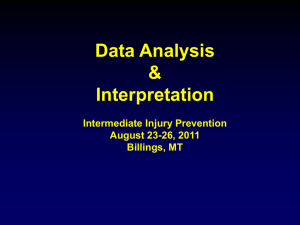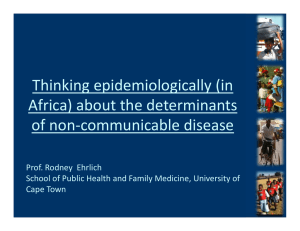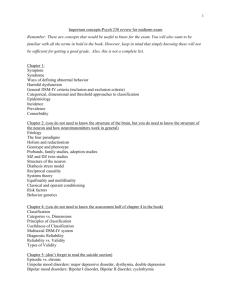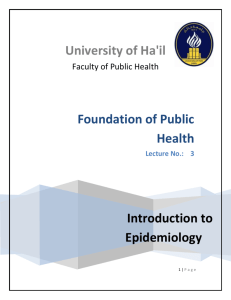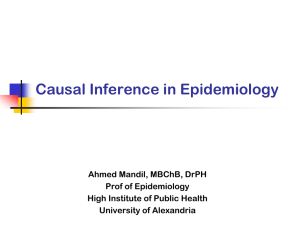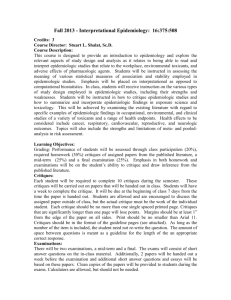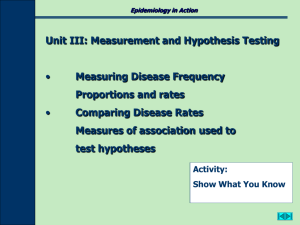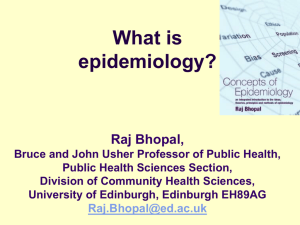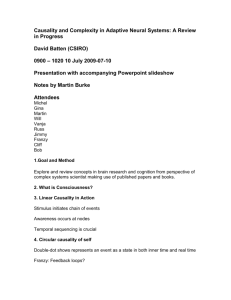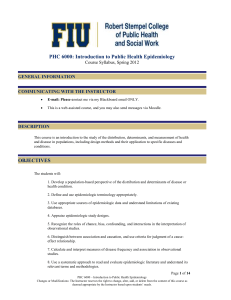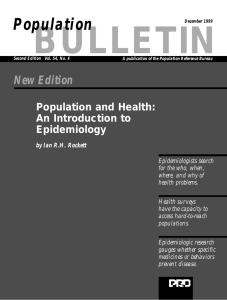Ch. 2 Friis
advertisement
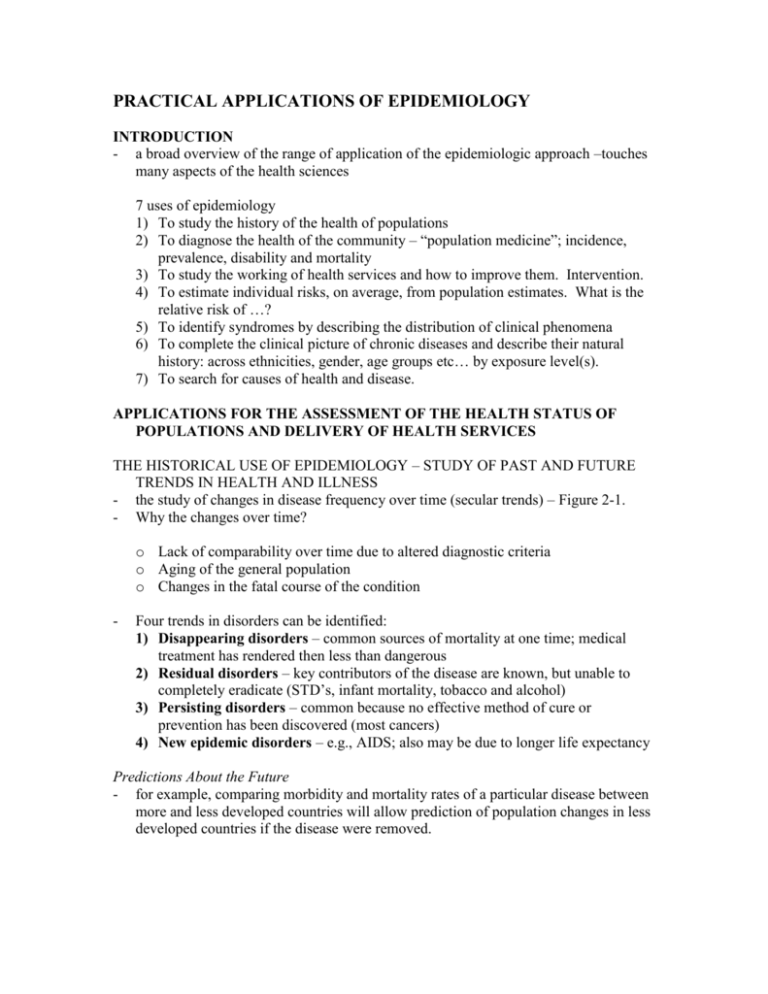
PRACTICAL APPLICATIONS OF EPIDEMIOLOGY INTRODUCTION - a broad overview of the range of application of the epidemiologic approach –touches many aspects of the health sciences 7 uses of epidemiology 1) To study the history of the health of populations 2) To diagnose the health of the community – “population medicine”; incidence, prevalence, disability and mortality 3) To study the working of health services and how to improve them. Intervention. 4) To estimate individual risks, on average, from population estimates. What is the relative risk of …? 5) To identify syndromes by describing the distribution of clinical phenomena 6) To complete the clinical picture of chronic diseases and describe their natural history: across ethnicities, gender, age groups etc… by exposure level(s). 7) To search for causes of health and disease. APPLICATIONS FOR THE ASSESSMENT OF THE HEALTH STATUS OF POPULATIONS AND DELIVERY OF HEALTH SERVICES THE HISTORICAL USE OF EPIDEMIOLOGY – STUDY OF PAST AND FUTURE TRENDS IN HEALTH AND ILLNESS - the study of changes in disease frequency over time (secular trends) – Figure 2-1. - Why the changes over time? o Lack of comparability over time due to altered diagnostic criteria o Aging of the general population o Changes in the fatal course of the condition - Four trends in disorders can be identified: 1) Disappearing disorders – common sources of mortality at one time; medical treatment has rendered then less than dangerous 2) Residual disorders – key contributors of the disease are known, but unable to completely eradicate (STD’s, infant mortality, tobacco and alcohol) 3) Persisting disorders – common because no effective method of cure or prevention has been discovered (most cancers) 4) New epidemic disorders – e.g., AIDS; also may be due to longer life expectancy Predictions About the Future - for example, comparing morbidity and mortality rates of a particular disease between more and less developed countries will allow prediction of population changes in less developed countries if the disease were removed. Populations Dynamics and Epidemiology - an extension of predictions about the future taking into consideration deaths, births and migration; demographic transition THE HELATH OF THE COMMUNITY - Table 2-2 (chapter 4 in more detail) - To some extent, determined by racial, ethnic, religious and SES factors WORKING OF HEALTH SERVICES: OPERATIONS RESEARCH AND PROGRAM EVALUATION - Involves the study of placement of health services in a community and the optimum utilization of such services Operations research strives to answer the following kinds of questions, among others: 1) What health services are not being supplied by an agency in the community? 2) Is a particular health service excessively duplicated in the community? 3) What segments of the community are the primary utilizers of a service, and which segments are being underserved? 4) What is the most efficient organizational and staff power configuration? 5) What characteristics of the community, providers, and patients affect service delivery and outcome? 6) What procedures could be used to assess, match and refer patients to service facilities? - Additionally, program evaluation can also be accomplished: o Methods for selecting target populations to be included in the evaluation o Design of instruments for data collection o Delimitation of types of health-related data to collect o Methods for assessment of health care needs APPLICATIONS RELEVANT TO DISEASE ETIOLOGY CAUSALITY IN EPIDEMIOLOGIC RESEARCH - difficult to associate cause and effect; e.g., no single cause of CVD or lung cancer RISK FACTORS DEFINED - due to difficulty in associating cause and effect, refer to an exposure that is associated with a risk factor for the disease 1) The frequency of the disease varies by category or value of the factor 2) The risk factor must precede the onset of the disease. 3) The observed association must not be due to any source of error (chapter 9). MODERN CONCEPTS OF CAUSALITY - over the course of time, causality and risk factors have become more appropriate and accepted when evaluating chronic diseases. - chronic disease and risk factor research began to emerge in the 1950’s: 1) a group of studies linking cigarette smoking to lung cancer led the US Dept. of Health, Education and Welfare, to publish a Surgeon General’s Report on Smoking and Lung Cancer in 1964; and 2) Morris et a. (1953) published an article in the Lancet linking physical inactivity to a higher incidence or heart attack. - current epidemiologic practice identifies nine issues associated with causality: 1) strength of association – the stronger the association, the more important the risk factor is, and the less likely it is to be subject to errors 2) consistency upon repetition 3) specificity – is development of the disease (CVD or smoking) specific to the exposure (physical inactivity or smoking) 4) time sequence – referring to latency period; time between exposure and development of the disease. The shorter the latency period, the easier to identify causing agent, and vice-versa. 5) biologic gradient – “a dose-response relationship” 6) plausibility – is it biologically plausible for the link to exist? 7) coherence of explanation – findings must fit with what is already known about the disease 8) experiment – “the natural kind”, of course; e.g., respiratory problems (or others) associated with living near manufacturing or energy plants 9) analogy – are the results analogous with previous findings, similar to #7; CVD, physical activity and NIDDM - the more of these “issues” that can be supported, the greater likelihood that cause and effect can be linked together causal inference and statistical inference frequently overlap, however they must be in congruence with each other for causality to be plausible - STUDY OF RISKS TO INDIVIDUALS - 2 main types (chapter 6): 1) Case-control – compares a group of well individuals to a group of diseased individuals (any of several dependent variables); and, 2) Cohort study – a well-group is measured in terms of exposure and followed with respect to development of the disease - but still, the risk to the individual? Very difficult; remember epidemiology is “population medicine” ENLARGEMENT OF THE CLINICAL PICTURE OF DISEASE - by definition, epidemiology accomplishes this PREVENTION OF DISEASE (3 stratetgies) 1) primary prevention – designed to reduce the occurrence of the disease; i.e., education on risk factors associated with development of the disease 2) secondary prevention – the intent is to reduce the progress of disease; early cancer detection screening programs 3) tertiary prevention – designed to reduce the limitation of disability from disease; physical therapy and rehabilitation programs

